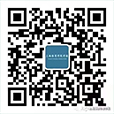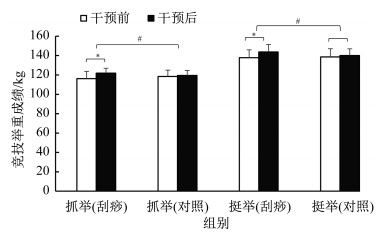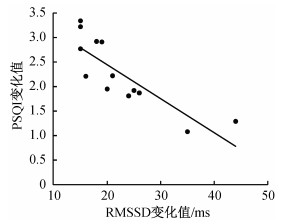Effects to Resist Sport Fatigue Based on the Testing of the Heart Rate Variability with the Gua Sha Therapy of Traditional Chinese Medicine
-
摘要:目的 通过测量国家男子举重队运动员的心率变异性(HRV),判断其正常训练后的疲劳状态,探索中医刮痧疗法在竞技体育领域的应用价值。方法 筛选出26名冬训期间(试验期间)处于运动性疲劳状态的国家男子举重队运动员,分为刮痧组和对照组(每组13人)。刮痧组除接受竞技举重训练外,另接受12周(每周2次,共24次)的中医刮痧干预治疗,对照组仅接受竞技举重训练。组内比较采用配对样本t检验、组间比较采用独立样本t检验,对竞技举重训练中的成绩、心率变异性时域和频域主要指标、匹兹堡睡眠质量指数(PSQI)进行监测与分析。结果 刮痧组竞技训练抓举和挺举成绩增加值[(5.37±0.80)kg和(5.87±1.04)kg]显著高于对照组[(1.00±0.31)kg和(1.46±0.42)kg](P < 0.05)。刮痧组心率变异性的时域指标(P < 0.05)、频域指标[低频(P < 0.05)、低频与高频比值(P < 0.01)]的保持效果、PSQI(P < 0.01)显著优于对照组,且PSQI变化值与时域指标相邻RR间期差值的均方根变化值呈负相关(r=-0.781,P < 0.05)。结论 在竞技举重训练导致的运动性疲劳恢复中合理进行中医刮痧干预治疗,能提升运动员的恢复效果,体现为自主神经调节中副交感神经活动明显增强;中医刮痧干预还可提高运动员的睡眠质量,从而提升抗运动性疲劳效果。Abstract:Objective By measuring the heart rate variability (HRV) of the national men's weightlifting team athletes, to judge their fatigue state after normal training, and to explore the application value of Gua Sha therapy of traditional Chinese medicine in the field of competitive sports.Methods 26 athletes of national men's weightlifting team were selected and divided into Gua Sha group and control group (13 in each group). In addition to competitive weightlifting training, the Gua Sha group received Gua Sha therapy for 12 weeks (twice a week, 24 times in total), while the control group only received competitive weightlifting training. Paired sample t-test was used for intra group comparison, and independent sample t-test was used for inter group comparison. The performance of competitive weightlifting training, heart rate variability in time domain and frequency domain, and Pittsburgh sleep quality index (PSQI) were monitored and analyzed.Results The increased scores of snatch and clean and jerk in Gua Sha Group[(5.37±0.80) kg and (5.87±1.04) kg] were significantly more than those in control group[(1.00±0.31) kg and (1.46±0.42) kg] (P < 0.05). The time domain index (P < 0.05), frequency domain index[low frequency (P < 0.05), low frequency to high frequency ratio (P < 0.01)] and PSQI (P < 0.01) of the Gua Sha group were significantly better than those of the control group, and the change of PSQI was negatively correlated with the root mean square of the sum of the squares of the difference in the time domain intermediate period (r=-0.781, P < 0.05).Conclusion In the recovery of sports fatigue caused by competitive weightlifting training, reasonable Gua Sha therapy of traditional Chinese medicine can improve the recovery effect of athletes, which is embodied in the obvious enhancement of parasympathetic nerves activity in autonomic nervous regulation; Gua Sha therapy can also improve the sleep quality of athletes, so as to enhance the effect of anti-sport fatigue.
-
训练实践中计划的有效实施和机体对负荷的良好适应是运动员竞技成绩提高的重要前提。在训练过程中,实施负荷刺激能促使运动员个体发生适应性变化,产生自组织现象,并导致机体产生器质性变化。训练刺激可导致运动性疲劳并通过恢复调整使竞技水平提升,这是人体适应训练的基本规律。在竞技训练过程中,对运动员实施机能监测是非常关键的环节,而在运动表现方面,运动训练从产生疲劳到过度训练的过程历经4个阶段:对运动表现无影响、可能对运动表现无影响、运动表现可能下降、运动表现下降[1]。人体生理、生化、心理等方面的发展表现为:首先改变神经元功能和运动单位募集;其次减少运动协调、改变兴奋收缩偶联、减少肌肉和肝糖原、减缓心率和血压增加、改变免疫功能和交感神经活动、出现情绪不安;最后出现力量下降、糖酵解能力降低、疾病和感染发生、激素水平改变、情感和睡眠不佳等现象。
中医刮痧疗法是极具中医临床特色的外治法之一,其施术于皮肤,作用于经络穴位,通过对穴位穴区经络进行不同刺激(不同的刮拭力度和面积)激发体内自愈功能,调节人体功能状态。现代医学研究[2]认为,中医刮痧疗法是一种通过刺激皮肤、肌肉、经脉穴位调整全身循环血量、拉大细胞间距、产生毛细血管壁内外压力差,从而提高人体免疫水平、修复再生能力与整合能力的传统保健和治疗手段。中医刮痧疗法干预的优势病种包括运动性疲劳,具有明显治疗效果的症状是骨关节、肌肉劳损及神经性功能障碍[3-4]。国内外临床研究表明,刮痧具有减少疼痛[5]、提高皮肤温度[6]和血液流速[7]、调节神经系统平衡[8]与提高竞技能力[9]等功效。基础研究结果显示,刮痧可以提高血红素加氧酶、神经元型一氧化氮合酶、组胺水平[10-11]及成纤维细胞的活化程度[12]。以上研究结果说明中医刮痧疗法可缓解运动性疲劳。中医针灸被列入人类非物质文化遗产,刮痧器具的国际化(国际标准化组织ISO 20308)和刮痧操作规范(国家标准GB/T 21709.22)的颁布实施,推动了中医刮痧疗法的国际化进程[13-14]。
心率变异性(heart rate variability,HRV)是体现自主神经功能变化的无创指标之一。自主神经系统兴奋性与个体对体育锻炼负荷的适应程度高度相关。人体通过交感神经和副交感神经2种成分的协调与对抗维持体内各脏器的功能,从而实现对生理功能和环境应激反应的精细调节。HRV反映了自主神经张力的变异程度,变异程度越大说明自主神经系统对外部环境变化的敏感性越高,对心血管的调控能力越强。自主神经系统兴奋性与运动适应的相关性成为运动处方开设、竞技训练计划安排、功能评价的科学依据[15-16]。本文通过测量国家男子举重队运动员的HRV,判断其正常训练后的疲劳状态,探索中医刮痧疗法在竞技体育领域的应用价值。
1. 研究对象与方法
1.1 研究对象
研究对象为国家男子举重队运动员,经过干预前1周进行的主观疲劳评定(rating perceived exertion,RPE)[17]和生化指标(睾酮、肌酸激酶、血尿素氮、皮质醇)[18]评定,确定冬训期间(试验期间)处于运动性疲劳状态者共26人。导致运动性疲劳的竞技举重训练计划由教练员执行,在干预过程中每2周进行1次RPE和生化指标检测。经调查,试验期间所有研究对象均无直接损伤,也无因旧伤导致的影响正常训练的情况,均经过动作筛查测试和等速平衡测试后达到正常训练标准[19]。依据竞技训练水平、体质量级别和调查对象数量,将26人分为刮痧组和对照组,每组13人。刮痧组:国际级运动健将3名、运动健将7名、国家一级运动员3名;年龄为18.0~28.5岁,平均年龄为(25.6±1.1)岁;体质量为60~95 kg,平均体质量为(84.47±2.55)kg;体质量指数(body mass index,BMI)为21~24 kg/m2,平均BMI为(22.12±2.73)kg/m2;训练年限为6.0~13.5 a,平均训练年限为(8.22±1.11)a。对照组:国际级运动健将3名、运动健将7名、国家一级运动员3名;年龄为17~29岁,平均年龄为(24.2±1.5)岁;体质量为58~92 kg,平均体质量为(84.47±2.55)kg;BMI为21.2~24.6 kg/m2,平均BMI为(23.27±2.41)kg/m2;训练年限为6.5~13 a,平均训练年限为(9.43±1.52)a。所有研究对象被告知刮痧干预治疗的研究目的、风险、益处、隐私保护、报酬等,并按照要求填写告知同意书。
1.2 研究方法
1.2.1 试验设计
为了探索中医刮痧干预竞技举重训练疲劳恢复的效果,本文测试HRV变化情况以监测运动员自主神经功能状态的变化,评价自主神经系统兴奋性与运动员对训练负荷适应程度的相关性。自变量为12周(每周2次,共24次)中医刮痧干预治疗,因变量为竞技举重训练中的成绩、HRV时域和频域主要指标、匹兹堡睡眠质量指数(Pittsburgh sleep quality index,PSQI)。严格控制无关变量,保证相同的训练环境、训练任务、休息时间和营养配备。试验时间为2017年11月至2018年2月(冬训转训期间),地点在海南省五指山市举重训练基地康复实验室,试验流程如图 1所示。刮痧组接受常规放松训练的同时,每星期二、星期四上午各接受1次专业中医刮痧干预治疗,共进行12周;对照组仅接受常规放松训练。
1.2.2 刮痧干预
由2名具有一级以上保健刮痧师资格的工作人员进行中医刮痧干预治疗,刮痧部位为头、颈、背、腰、四肢,每个部位按照“点、线、面、位”刮痧原则刮20次(前7次相对轻刮,中间7次相对重刮,最后6次相对轻刮)。主要刮拭肌肉附着点、沿经络循行和动脉血流方向、疼痛表面和神经支配区感传方向、支配内脏神经对应的背部脊椎两侧部位[20],根据竞技举重训练中运动员的体型特征和中医刮痧疗法的特点,并在征求国内刮痧权威专家(杨金生、王莹莹等)的意见后,重点刮拭部位为脾俞、章门、血海、阴陵泉、三阴交等穴位[14, 21]。痧象为潮红或紫红斑状;被刮对象感觉有一点疼痛,但完全可以耐受。刮痧时间为每星期二和星期四8:30—11:30。刮痧干预手法选取补法、平补平泻,刮拭力度≤4.9 N[9]。刮痧干预的环境按照国际刮痧标准执行[13-14],必须保持封闭不通风以免影响干预效果[21-23]。
1.2.3 测试指标
在试验过程中,测试竞技举重训练项目(抓举、挺举)的成绩、HRV时域和频域主要指标[24]、PSQI。在试验前后1周内测试抓举和挺举成绩的最大值,即在训练周的星期三和星期五下午正常训练时进行抓举和挺举测试。正式训练过程中,由轻到重、逐步过渡到最大1次重复次数的抓举、挺举过程,获得竞技举重成绩。
采用奥地利SCHUHFRIEDF公司生产的生物反馈系统4.2及2000型软件进行HRV测试。取样时间为5 min,频率为100 Hz,测试和数据收集过程严格按照HRV的测试标准进行,即先休息10 min后再进入康复室进行测试。被测试者要求正常平静呼吸,测试环境温度设定为25~27 ℃,湿度为50%~60%。HRV时域指标中全部正常RR间期的标准差(standard deviation of normal-to-normal intervals,SDNN)、相邻RR间期差值的均方根(root mean square of successive differences,RMSSD)、相邻RR间期差值大于50 ms的心搏次数占总心搏次数的百分比(more than 50 ms by the total number of normal-to-normal intervals,pNN50)3个指标主要反映抗疲劳症状。采用统计方法定量分析心动周期的变化特征以反映HRV时域指标。SDNN的生理意义主要体现心率变异的总和,SDNN变大被认为是人体的调节功能提高。通过计算相邻心动周期的变化反映HRV的快速变化能力,RMSSD增大说明人体的调节能力提高,变化越大调节能力越强,同时也反映了迷走神经功能的加强。pNN50反映了人体心动周期随心脏搏动的变化情况,它是HRV的快速变化成分,pNN50增大说明心动周期随心脏搏动快速变化的能力增强,同样也反映迷走神经的调节功能提高。HRV是监测疲劳恢复的指标,HRV变化越大说明运动员体能恢复越好[15-16]。运用傅里叶变换和自回归模型反映HRV频域指标。将随时间变化的心率波动曲线分解成不同频率、不同振幅正弦曲线之和的频谱(功率谱)[15]。HRV频域指标主要通过高频率(high frequency,HF)、低频率(low frequency,LF)、低频率与高频率比值(LF/HF比值)3个指标体现。
本文采用PSQI主观评定睡眠质量,该量表包括睡眠质量、入睡时间、睡眠时间、睡眠效率、睡眠障碍、催眠药物、日间功能障碍7个维度。采用4级计分法,每个维度得分为0~3分,量表总分为0~21分,总分越高说明睡眠质量越差[25-26]。
1.3 统计学方法
应用SPSS 21.0软件进行统计分析。数据以平均数±标准差形式表示,组内试验前后数据的比较采用配对样本t检验,组间的比较采用独立样本t检验。刮痧组运动员PSQI与RMSSD的相关关系采用Pearson相关性检验进行分析。以P < 0.05表示差异显著,P < 0.01表示差异非常显著。
2. 结果与分析
2.1 研究结果
2.1.1 中医刮痧干预对正常举重训练成绩的影响
分析中医刮痧抗运动性疲劳的竞技训练效果(图 2),结果显示,刮痧组运动员的竞技举重专项抓举和挺举成绩均较试验前明显提高,抓举成绩从(116.39±7.53)kg提高到(121.77±5.18)kg(t=-5.51,P < 0.05),挺举成绩从(137.82±8.13)kg提高到(143.69±7.81)kg(t=-7.39,P<0.05),差异均有统计学意义。对照组运动员的竞技成绩也有所提高,抓举成绩从(118.46±6.51)kg提高到(119.46±5.22)kg(P>0.05),挺举成绩从(138.62±8.45)kg提高到(140.08±6.93)kg(P>0.05),但差异均无统计学意义。2组间比较结果显示,刮痧组运动员的抓举和挺举成绩增加值分别为(5.37±0.80)kg和(5.87±1.04)kg,均大于对照组的(1.00±0.31)kg(t=4.16,P < 0.05)和(1.46±0.42)kg(t=4.34,P<0.05),差异均有统计学意义。
2.1.2 中医刮痧干预对HRV时域指标的影响
由表 1可见,刮痧组运动员中医刮痧干预后的SDNN、RMSSD和pNN50均较干预前显著提高,差异均有统计学意义(P<0.05);对照组这3个指标虽有变化,但前后差异均不显著(P>0.05)。中医刮痧干预后,刮痧组运动员的SDNN、RMSSD和pNN50变化值均高于对照组,差异均有统计学意义(P<0.05)。
表 1 中医刮痧前后2组国家男子举重队运动员的HRV时域指标变化Table 1. Value change in time domain of HRV of male weightlifters before and after Gua Sha in both groups指标 组别 干预前 干预后 ta Pa 干预前后差值 tb Pb SDNN/ms 对照组 104.44±24.11 105.35±19.17 -1.04 0.611 0.91±0.22 -5.07 0.013 刮痧组 100.37±20.13 111.16±23.41 -7.01 0.033 10.79±3.18 RMSSD/ms 对照组 101.33±16.82 105.36±19.77 -3.39 0.172 4.03±1.57 -7.53 0.028 刮痧组 103.41±21.44 125.67±22.61 -10.55 0.012 22.26±7.31 pNN50/% 对照组 62.34±11.25 67.39±9.11 -2.11 0.114 5.05±1.53 -3.48 0.025 刮痧组 45.64±9.71 57.33±7.66 -8.06 0.028 11.69±3.44 注:n=13;数据以平均数±标准差形式表示;a表示组内刮痧干预前后比较;b表示组间刮痧干预后比较;HRV表示心率变异性;SDNN表示全部正常RR间期的标准差;RMSSD表示相邻RR间期差值的均方根;pNN50表示相邻RR间期差值>50 ms的心搏次数占总心搏次数的百分比。 2.1.3 中医刮痧干预对HRV频域指标的影响
由表 2可见,刮痧组运动员的HRV频域指标LF、HF值在刮痧干预前后的保持效果良好,并稍有下降,但差异均无显著性(P>0.05),这是刮痧抗疲劳的具体体现;而干预后刮痧组LF/HF值较干预前有显著增加(P<0.05)。对照组运动员由于竞技举重训练导致的运动性疲劳刺激,训练后LF值和LF/HF值均较训练前提高,HF值较训练前下降,差异均有统计学意义(P<0.05)。2组间比较结果显示,刮痧组运动员在刮痧干预后LF值下降值和LF/HF值的增高值均大于对照组,差异均有统计学意义(P<0.05),说明中医刮痧干预在抗运动性疲劳中对HRV频域指标的影响显著。
表 2 中医刮痧前后2组国家男子举重队运动员的HRV频域指标变化Table 2. Value change in frequency domain of HRV of male weightlifters before and after Gua Sha in both groups指标 组别 干预前 干预后 ta Pa 干预前后差值 tb Pb LF/Hz 对照组 0.075±0.020 0.084±0.019 -5.88 0.021 0.009±0.001 6.86 0.018 刮痧组 0.077±0.022 0.064±0.023 4.60 0.238 -0.013±0.002 HF/Hz 对照组 0.254±0.045 0.237±0.037 3.49 0.010 -0.017±0.001 -1.37 0.428 刮痧组 0.256±0.052 0.253±0.052 0.35 0.655 -0.003±0.001 LF/HF 对照组 0.319±0.126 0.367±0.108 -2.39 0.013 0.048±0.010 -1.49 0.008 刮痧组 0.750±0.020 0.840±0.019 -5.70 0.021 0.090±0.010 注:n=13;数据以平均数±标准差形式表示;a表示组内刮痧干预前后比较;b表示组间刮痧干预后比较;HRV表示心率变异性;LF表示低频率;HF表示高频率。 2.1.4 中医刮痧干预对睡眠质量的影响及与HRV的关系
由表 3可见,在刮痧干预后,刮痧组运动员的PSQI较中医刮痧干预前显著下降(P<0.01),且显著低于对照组干预后的评分(P<0.01),说明刮痧干预对运动员的睡眠质量有显著的提升效果。通过Pearson相关性分析发现,刮痧组运动员在刮痧干预前后的PSQI变化值(差值)与RMSSD变化值(差值)呈负相关(r=-0.781,P<0.05)(图 3)。
表 3 中医刮痧前后2组国家男子举重队运动员的PSQITable 3. PSQI of male weightlifters before and after Gua Sha in both groups组别 干预前 干预后 ta Pa 干预前后差值 tb Pb 对照组 6.73±2.75 7.11±3.18 -3.61 0.072 0.38±0.02 8.03 0.000 刮痧组 6.81±2.34 4.54±1.78 7.26 0.000 2.27±1.22 注:n=13;数据以平均数±标准差形式表示;a表示组内刮痧干预前后比较;b表示组间刮痧干预后比较;PSQI表示匹兹堡睡眠质量指数。 2.2 结果分析
2.2.1 传统中医刮痧促进竞技成绩提升的作用
竞技成绩的变化主要由训练负荷决定,而训练负荷的调整取决于运动员疲劳恢复的效果。本文研究对象中,中医刮痧干预促进了竞技举重(抓举和挺举)成绩的提高,这种变化是在经过试验设计控制无关变量后、在正常举重训练干预下添加干预的结果,即12周内常规疲劳状态下坚持训练能提高11 kg以上的举重平均成绩,说明传统刮痧在抗运动性疲劳方面能起到明显的效果。针对中医刮痧的临床生理学研究显示,中医刮痧可提高皮肤温度[6]和血液流速[7]、调节神经系统平衡[8],其机制是刮痧直接作用于皮肤,能调动人体1/3以上的循环血量,通过“挤、压、推、拍、刮、点、按”等手段使细胞间距拉大形成了局部的透析功能,利用血管壁内外压力差使血液毒素暂时渗透到管壁外,并经由人体自身溶血功能排出体外[27]。通过中医刮痧干预可使运动训练产生的疲劳在最短时间内消失,从而较快地进行新的训练干预。举重运动员从事专业训练6 a以上,身体功能基本适应了举重训练项目的属性,导致其在正常的游戏或其他项目的运动中出现竞技能力的协调性、速度耐力与爆发力、绝对力量等体能素质的失衡。常规竞技举重训练主要通过专业训练项目(抓举和挺举)和专项辅助项目(高翻半挺、硬拉、前蹲、速拉、下蹲抓)等进行专项训练,出现身体功能与机能的不平衡是正常现象,因为肌群之间功能的失衡是长年举重训练适应的结果[19]。然而,中医刮痧干预提高了运动员的自我恢复能力,达到了自我调整的效果,改善了身体在常规训练下的恢复效果和动作表现效果,即通过中医刮痧干预提高了竞技训练效果。本文中刮痧组运动员在干预后抓举和挺举的竞技成绩总和提高了11 kg以上,而对照组成绩提高不足3 kg,这一结果说明刮痧干预改善了运动员在疲劳运动训练后的恢复效果,从而影响训练负荷的调控,最终促进举重竞技能力的提高。
2.2.2 刮痧抗运动性疲劳的HRV分析
本文采用HRV的时域和频域指标监控运动性疲劳现象。HRV时域和频域指标在同一现象中虽然包括不同指标,但反映了相同的问题,即RMSSD对应的HF的变化体现心脏副交感神经传出活动的节律变化,总体反映心率变异的快速变化。运动训练刺激后,人体由于心脏适应而出现RMSSD或HF的变化,监测到的数据间接反映了心脏的功能变化。在本文中,在刮痧干预后,刮痧组运动员的时域指标RMSSD显著(P < 0.05)提高,而对照组变化不显著。SDNN和pNN50分别代表心率变异的总体特征和心动周期随着心搏的变异情况(HRV的快速变化成分),刮痧组运动员干预前后的SDNN和pNN50的变化差异也有显著性(P < 0.05)。这一结果说明,刮痧干预能提高机体的反应能力,即调节由于训练失衡导致的疲劳,从而使运动员在抗运动性疲劳过程中比未进行刮痧干预的对照组恢复更快,在后期训练中更能适应新的负荷干预而取得良好的竞争成绩,这与竞技举重成绩的变化基本相符。由于训练刺激导致运动员机体发生适应性变化,基于人体复杂性理论、人体微观复杂性体现机体多样性,生命复杂系统会发生熵增现象,而训练特异性促进自我机体自组织过程,同时在恢复过程中从外界补充适当的能量,这一过程体现了生命复杂系统熵减现象[28]。长时间(4个月以上)进行训练,即由于特异性刺激和自组织进化而涌现出新的机体结构,外在表现为竞技训练成绩提高,这也是人体整体功能变化的“刺激—适应—进化—涌现”(stimulation-adaptation-evolution-emergence,SAEE)模型的进化过程[29]。
刮痧组运动员HRV频域指标的HF值无显著性下降,而对照组运动员由于训练而发生显著性下降(P < 0.05)。刮痧组运动员的中医刮痧干预有助于维持他们的机能变化,而对照组运动员的HF值由于训练导致显著下降,这属于训练引起的正常变化。刮痧组的LF值下降不显著,而对照组的LF值显著上升(P < 0.05)且具有统计学意义。心脏交感神经与副交感神经传出纤维通过压力反射的耦合作用共同介导心率波动变化,LF值的提高体现了心脏交感神经传出活动增强,机体恢复功能受限。因此,对照组LF值显著上升说明常规训练导致机体发生疲劳,这是训练导致的正常反应,刮痧组的LF值变化不大主要是由于刮痧刺激促进副交感神经传出活动增强,体现了刮痧干预的抗运动性疲劳效果。LF/HF值可衡量交感神经与副交感神经的变化,其比值增高说明交感神经的兴奋性增强、副交感神经的兴奋性减弱。刮痧组该比值降低反映了副交感神经活动增强,也体现了刮痧干预的抗运动性疲劳效果。以上结果表明,12周的刮痧干预调整了由于多年训练导致的交感神经兴奋性暂时增强这一现象,增加了副交感神经的活动,是一种抗运动性疲劳、调整机体平衡的良好措施。
2.2.3 刮痧提高睡眠质量且与HRV指标相关
表 3数据说明,刮痧组运动员的睡眠质量明显优于对照组,刮痧组PSQI变化值约是对照组的6倍,说明中医刮痧在抗运动性疲劳过程中提高了睡眠质量,而睡眠质量提高使个体整体功能提升。人体通过宏观行为(如睡眠)对微观结构进行测度和干预,这属于主动健康的医学模式[30]。通过人体宏观行为可以测度机体微观上的活力状态,如果宏观行为对机体有正向效果,则微观上的活力模式产生速度也会加快[31-32],即人体宏观信息熵升高,微观结构进一步复杂化。在深度睡眠期间人体活力水平最高,其可以从微观上评价机体活力状态,体现了人体的自我修复能力。中医刮痧提升了睡眠质量,是自我修复能力增加的主要原因。通过对PSQI变化值与RMSSD变化值进行Pearson相关性分析发现,睡眠质量的提高(PSQI下降)促进了心脏副交感神经兴奋性的增强(RMSSD提高),间接证明了刮痧具有抗运动性疲劳的效果。在治疗失眠过程中中医极力推荐刮痧疗法,并表现出很好的临床效果[33-35]。现代医学主要从自律神经失调与睡眠障碍的关系方面论证睡眠质量变化的神经机制[36]。
3. 结论
在竞技举重训练导致的运动性疲劳恢复中合理进行中医刮痧干预治疗,能提升运动员的恢复效果,体现为自主神经调节中副交感神经活动明显增强。此外,中医刮痧干预还可以提高运动员的睡眠质量,从而提升抗运动性疲劳效果。
作者贡献声明:王兴泽:完成试验,收集数据,撰写论文;于杰:管理、设计试验,收集部分数据;陈佩杰:设计试验,梳理论文逻辑思路,审核、指导修改论文。 -
表 1 中医刮痧前后2组国家男子举重队运动员的HRV时域指标变化
Table 1 Value change in time domain of HRV of male weightlifters before and after Gua Sha in both groups
指标 组别 干预前 干预后 ta Pa 干预前后差值 tb Pb SDNN/ms 对照组 104.44±24.11 105.35±19.17 -1.04 0.611 0.91±0.22 -5.07 0.013 刮痧组 100.37±20.13 111.16±23.41 -7.01 0.033 10.79±3.18 RMSSD/ms 对照组 101.33±16.82 105.36±19.77 -3.39 0.172 4.03±1.57 -7.53 0.028 刮痧组 103.41±21.44 125.67±22.61 -10.55 0.012 22.26±7.31 pNN50/% 对照组 62.34±11.25 67.39±9.11 -2.11 0.114 5.05±1.53 -3.48 0.025 刮痧组 45.64±9.71 57.33±7.66 -8.06 0.028 11.69±3.44 注:n=13;数据以平均数±标准差形式表示;a表示组内刮痧干预前后比较;b表示组间刮痧干预后比较;HRV表示心率变异性;SDNN表示全部正常RR间期的标准差;RMSSD表示相邻RR间期差值的均方根;pNN50表示相邻RR间期差值>50 ms的心搏次数占总心搏次数的百分比。 表 2 中医刮痧前后2组国家男子举重队运动员的HRV频域指标变化
Table 2 Value change in frequency domain of HRV of male weightlifters before and after Gua Sha in both groups
指标 组别 干预前 干预后 ta Pa 干预前后差值 tb Pb LF/Hz 对照组 0.075±0.020 0.084±0.019 -5.88 0.021 0.009±0.001 6.86 0.018 刮痧组 0.077±0.022 0.064±0.023 4.60 0.238 -0.013±0.002 HF/Hz 对照组 0.254±0.045 0.237±0.037 3.49 0.010 -0.017±0.001 -1.37 0.428 刮痧组 0.256±0.052 0.253±0.052 0.35 0.655 -0.003±0.001 LF/HF 对照组 0.319±0.126 0.367±0.108 -2.39 0.013 0.048±0.010 -1.49 0.008 刮痧组 0.750±0.020 0.840±0.019 -5.70 0.021 0.090±0.010 注:n=13;数据以平均数±标准差形式表示;a表示组内刮痧干预前后比较;b表示组间刮痧干预后比较;HRV表示心率变异性;LF表示低频率;HF表示高频率。 表 3 中医刮痧前后2组国家男子举重队运动员的PSQI
Table 3 PSQI of male weightlifters before and after Gua Sha in both groups
组别 干预前 干预后 ta Pa 干预前后差值 tb Pb 对照组 6.73±2.75 7.11±3.18 -3.61 0.072 0.38±0.02 8.03 0.000 刮痧组 6.81±2.34 4.54±1.78 7.26 0.000 2.27±1.22 注:n=13;数据以平均数±标准差形式表示;a表示组内刮痧干预前后比较;b表示组间刮痧干预后比较;PSQI表示匹兹堡睡眠质量指数。 -
[1] National Strength & Conditioning Association. Essentials of strength training & conditioning[M]. 3rd ed. Champaign: Human Kinetics Publishers, 2008: 68-90
[2] 王莹莹, 杨金生. 中国刮痧规范研究现状及展望[J]. 中国中医药信息杂志, 2011, 18(12): 4-6 doi: 10.3969/j.issn.1005-5304.2011.12.002 [3] 姜荣荣, 徐桂华, 陈华, 等. 从文献计量学角度探刮痧治疗的优势病种[J]. 中医学报, 2014, 29(5): 756-758 https://www.cnki.com.cn/Article/CJFDTOTAL-HNZK201405052.htm [4] 于素梅. 刮痧治疗运动性肩袖损伤56例疗效的探讨[J]. 体育科学, 2001, 21(5): 50 doi: 10.3969/j.issn.1000-677X.2001.05.030 [5] BRAUN M, SCHWICKERT M, NIELSEN A, et al. Effectiveness of traditional Chinese "scraping" therapy in patients with chronic neck pain: A randomized controlled trial[J]. Pain Med, 2011, 12(3): 362-369 doi: 10.1111/j.1526-4637.2011.01053.x
[6] XU Q Y, YANG J S, ZHU B, et al. The effects of scraping therapy on local temperature and blood perfusion volume in healthy subjects[J]. Evid Based Complement Alternat Med, 2012: 490292 http://labs.europepmc.org/abstract/MED/22666292
[7] NIELSEN A, KNOBLAUCH N T, DOBOS G J, et al. The effect of scraping treatment on the microcirculation of surface tissue: A pilot study in healthy subjects[J]. Explore (NY), 2007, 3(5): 456-466 doi: 10.1016/j.explore.2007.06.001
[8] WANG X, CHATCHAWAN U, NAKMAREONG S, et al. Effects of GUASHA on heart rate variability in healthy male volunteers under normal condition and weightlifters after weightlifting training sessions[J]. Evid Based Complement Alternat Med, 2015: 268471 http://www.ncbi.nlm.nih.gov/pubmed/26120346
[9] WANG X. The effects of Gua Sha therapy on the ability of weightlifting training: A randomized controlled trial[D]. Khon Kaen: Khon Kaen University, 2014: 109-110
[10] 徐东升, 王莹莹, 崔晶晶, 等. 刮痧对局部组织中神经元型一氧化氮合酶和组胺的影响[J]. 中国中医基础医学杂志, 2014, 20(11): 1547-1549 https://www.cnki.com.cn/Article/CJFDTOTAL-ZYJC201411035.htm [11] 崔向清, 蒋燕, 杨向竹, 等. 刮痧疗法对胆红素、SOD、IL-1、IL-6、白细胞、单胺类神经递质的影响初探[J]. 中医药学报, 2013, 41(1): 33-37 https://www.cnki.com.cn/Article/CJFDTOTAL-ZYXB201301014.htm [12] HAMMER W I. The effect of mechanical load on degenerated soft tissue[J]. J Bodyw Mov Ther, 2008, 12(3): 246-256 doi: 10.1016/j.jbmt.2008.03.007
[13] Traditional Chinese medicine Gua Sha instruments: ISO 20308: 2017[S/OL]. [2020-04-01]. http://iso.org/standard/67623.html
[14] 国家质量监督检验检疫总局, 国家标准化管理委员会. 针灸技术操作规范: 第22部分: 刮痧: GB/T 21709.22-2013[S]. 北京: 中国标准出版社, 2014: 1 [15] KAMATH M V, WATANABE M, UPTON A. Heart rate variability (HRV) signal analysis: Clinical applications[M]. Boca Raton: CRC Press, 2013: 14-25
[16] 王松涛. 运动与自主神经[M]. 北京: 北京体育大学出版社, 2007: 67-73 [17] FOSTER C, FLORHAUG J A, FRANKLIN J, et al. A new approach to monitoring exercise training[J]. J Strength Cond Res, 2001, 15(1): 109-115 http://europepmc.org/abstract/MED/11708692
[18] 洪雷, 郭子渊, 陈文斌, 等. 国家男子举重队赛前训练期生化参数分析[J]. 中国运动医学杂志, 2004, 23(6): 669-670 doi: 10.3969/j.issn.1000-6710.2004.06.017 [19] 于杰, 王兴泽. 优秀男子举重运动员精准训练特征分析[J]. 中国体育教练员, 2017, 25(3): 22-24 doi: 10.3969/j.issn.1006-8732.2017.03.009 [20] 杨金生, 王莹莹, 屈建峰, 等. 刮痧点线面位结合是临床获效的关键[J]. 中国康复理论与实践, 2011, 17(3): 300-301 doi: 10.3969/j.issn.1006-9771.2011.03.037 [21] 王兴泽, 陈佩杰, 于杰, 等. 物理疗法刮痧干预竞技举重训练的实验研究[J]. 上海体育学院学报, 2018, 42(3): 79-83 http://www.styb.cbpt.cnki.net/WKE/WebPublication/paperDigest.aspx?paperID=21eb6cb0-3c01-49d7-9553-5f81f34cad1e [22] CHIU J Y, GAU M L, KUO S Y, et al. Effects of Gua Sha therapy on breast engorgement: A randomized controlled trial[J]. J Nurs Res, 2010, 18(1): 1-10 doi: 10.1097/JNR.0b013e3181ce4f8e
[23] WANG X Z, CHEN P J, HUANG X Y, et al. Guasha improves the rating of perceived exertion scale score and reduces heart rate variability in male weightlifters: A randomized controlled trial[J]. J Tradit Chin Med, 2017, 37(1): 49-56 doi: 10.1016/S0254-6272(17)30026-2
[24] ORESHNIKOV E V, TIKHONOV V F, AGAFONKINA T V. Heart rate variability in weightlifters[J]. Fiziol Cheloveka, 2009, 35(4): 139-141 http://www.ncbi.nlm.nih.gov/pubmed/19799346
[25] 刘贤臣, 唐茂芹. 匹兹堡睡眠质量指数的信度和效度研究[J]. 中华精神科杂志, 1996, 29(2): 103-107 https://www.cnki.com.cn/Article/CJFDTOTAL-ZHMA199602018.htm [26] SMYTH C. The Pittsburgh sleep quality index[J]. Medsurg Nurs, 2003, 12(4): 261-262
[27] 杨金生, 王莹莹, 闫平慧, 等. 刮痧循经理论及生物学基础研究和标准体系制订与应用[Z]. 中华中医药学会科学技术进步奖推荐书, 2017: 2-18 [28] 张树龙, 吴永全. 自主神经与心率失常[M]. 北京: 北京大学医学出版社, 2016: 292-300 [29] 吴家睿. 后基因组时代的思考[M]. 上海: 上海科学技术出版社, 2007: 189-195 [30] 李祥臣, 俞梦孙. 主动健康: 从理念到模式[J]. 体育科学, 2020, 40(2): 83-89 https://www.cnki.com.cn/Article/CJFDTOTAL-TYKX202002010.htm [31] COSTA M D, GOLDBERGER A L, PENG C. Multiscale entropy analysis of complex physiologic timeseries[J]. Physical Review Letters, 2002, 89(6): 068102 doi: 10.1103/PhysRevLett.89.068102
[32] 薛定谔. 生命是什么[M]. 仇万煜, 左兰芬, 译. 海口: 海南出版社, 2017: 73-81 [33] 孟庆宇, 顾是, 孙洁净, 等. 刮痧治疗失眠选穴规律探讨[J]. 中国中医药现代远程教育, 2014, 12(10): 64-65 doi: 10.3969/j.issn.1672-2779.2014.10.041 [34] 陈丽娟, 林艺娟, 陈阿兰, 等. 砭石刮痧治疗非器质性失眠症34例[J]. 中医外治杂志, 2017, 26(2): 37-38 doi: 10.3969/j.issn.1006-978X.2017.02.022 [35] LI X S, QI L Z. Treatment of insomnia with Guasha: Scraping[J]. J Acupunct Tuina Sci, 2007, 5(6): 368-371 doi: 10.1007/s11726-007-0368-y
[36] 杨静修. 心率变异研究: 从健康养生到疾病诊疗[M]. 台北: 合记图书出版社, 2016: 378-396 -
期刊类型引用(5)
1. 周建华,王坤,商晓波,王叶,李帆,张丽曼,李敏菊. 循经刮痧联合雷火灸对缺血性脑卒中后肩手综合征患者运动功能和血液流变学的影响. 中国实用护理杂志. 2025(04): 260-266 .  百度学术
百度学术
2. 董庚鑫,李毅婷,洪影露,包大鹏. 富氢气体对高强度运动后本体感觉和肌肉耐力的影响. 中国组织工程研究. 2024(34): 5413-5418 .  百度学术
百度学术
3. 苏余,张韧仁,何毅. 中等强度运动积极影响注意缺陷多动障碍儿童的问题行为及心率变异性研究. 中国体育科技. 2023(05): 43-51 .  百度学术
百度学术
4. 陈灵兰,田小华,何花,蒋谷芬. 铜砭刮痧联合疏肝逐瘀汤加减干预气滞血瘀型冠心病的临床疗效及对患者血液流变学、心绞痛症状的影响. 临床和实验医学杂志. 2023(11): 1136-1140 .  百度学术
百度学术
5. 郭佳,曹春梅,张栋,郑满,张凌韬. 基于心率变异性预测急性高山病的效果评价. 现代预防医学. 2023(14): 2645-2650+2688 .  百度学术
百度学术
其他类型引用(9)





 下载:
下载:

